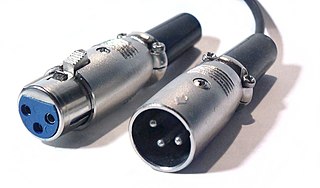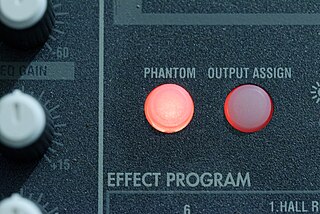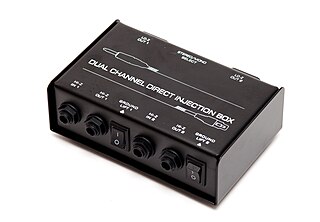
A microphone, colloquially called a mic, or mike, is a transducer that converts sound into an electrical signal. Microphones are used in many applications such as telephones, hearing aids, public address systems for concert halls and public events, motion picture production, live and recorded audio engineering, sound recording, two-way radios, megaphones, and radio and television broadcasting. They are also used in computers and other electronic devices, such as mobile phones, for recording sounds, speech recognition, VoIP, and other purposes, such as ultrasonic sensors or knock sensors.
Balanced audio is a method of interconnecting audio equipment using balanced interfaces. This type of connection is very important in sound recording and production because it allows the use of long cables while reducing susceptibility to external noise caused by electromagnetic interference. The balanced interface guarantees that induced noise appears as common-mode voltages at the receiver which can be rejected by a differential device.

DMX512 is a standard for digital communication networks that are commonly used to control lighting and effects. It was originally intended as a standardized method for controlling stage lighting dimmers, which, prior to DMX512, had employed various incompatible proprietary protocols. It quickly became the primary method for linking controllers to dimmers and special effects devices such as fog machines and intelligent lights.

The XLR connector is a type of electrical connector primarily used in professional audio, video, and stage lighting equipment. XLR connectors are cylindrical, with three to seven connector pins, and are often employed for analog balanced audio interconnections, AES3 digital audio, portable intercom, DMX512 lighting control, and for low-voltage power supply. XLR connectors are part of the international standard for dimensions, IEC 61076-2-103. The XLR connector resembles the DIN connector, but is larger, more robust and physically incompatible.

Phantom power, in the context of professional audio equipment, is DC electric power equally applied to both signal wires in balanced microphone cables, forming a phantom circuit, to operate microphones that contain active electronic circuitry. It is best known as a convenient power source for condenser microphones, though many active direct boxes also use it. The technique is also used in other applications where power supply and signal communication take place over the same wires.

A DI unit is an electronic device typically used in recording studios and in sound reinforcement systems to connect a high output impedance unbalanced output signal to a low-impedance, microphone level, balanced input, usually via an XLR connector and XLR cable. DIs are frequently used to connect an electric guitar or electric bass to a mixing console's microphone input jack. The DI performs level matching, balancing, and either active buffering or passive impedance matching/impedance bridging. DI units are typically metal boxes with input and output jacks and, for more expensive units, “ground lift” and attenuator switches.
Shure Inc. is an audio products corporation headquartered in the USA. It was founded by Sidney N. Shure in Chicago, Illinois, in 1925 as a supplier of radio parts kits. The company became a consumer and professional audio-electronics manufacturer of microphones, wireless microphone systems, phonograph cartridges, discussion systems, mixers, and digital signal processing. The company also manufactures listening products, including headphones, high-end earphones, and personal monitor systems.

A pop filter, pop shield or pop screen is a noise protection filter for microphones, typically used in a recording studio. It serves to reduce or eliminate popping sounds caused by the mechanical impact of fast-moving air on the microphone from plosives during recorded speech and singing. Pop filters can also keep saliva off the microphone during recording.

A boundary microphone is one or more small omnidirectional or cardioid condenser mic capsule(s) positioned near or flush with a boundary (surface) such as a floor, table, or wall. The capsule(s) are typically mounted in a flat plate or housing. The arrangement provides a directional half-space pickup pattern while delivering a relatively phase-coherent output signal.
The Shure SM57 is a low-impedance cardioid dynamic microphone made by Shure Incorporated and commonly used in live sound reinforcement and studio recording. It is one of the best-selling microphones in the world. It is used extensively in amplified music and has been used for speeches by every U.S. president since its introduction in 1965. In 2004, honoring its four decades of "solid, dependable performance", it was inducted into the first-ever TEC Awards TECnology Hall of Fame.

Georg Neumann GmbH is a manufacturer of professional recording microphones. It was founded by Georg Neumann and Erich Rickmann in 1928 and is based in Berlin, Germany. Its best-known products are condenser microphones for recording, broadcast, and live music production purposes. For several decades Neumann was also a leading manufacturer of cutting lathes for phonograph disks, and even ventured into the field of mixing desks. Today Neumann also manufactures preamplifiers, studio monitors, headphones, and audio interfaces.

The RCA Type 77-DX microphone is a poly-directional ribbon microphone, or pressure-gradient microphone, introduced by the RCA Corporation in 1954. It was preceded by the Type 77-D introduced in 1948. Its popularity and classic design has resulted in the 77-DX becoming an iconic microphone, used by broadcasters and media personalities such as Edward R. Murrow, David Letterman and Larry King.

The proximity effect in audio is an increase in bass or low frequency response when a sound source is close to a directional or cardioid microphone. Proximity effect is a change in the frequency response of a directional pattern microphone that results in an emphasis on lower frequencies. It is caused by the use of ports to create directional polar pickup patterns, so omni-directional microphones do not exhibit the effect
The Shure Beta 58A is a rugged dynamic supercardioid microphone developed by Shure Incorporated specifically for live vocal performances. The microphone won a TEC Award in 1996 for outstanding microphone technology.

A Y-cable, Y cable, or splitter cable is a cable with three ends: one common end and two other ends. The Y-cable can resemble the Latin letter "Y".

The Shure MV7 is a cardioid dynamic microphone used for podcasting and home studio applications. The MV7 was developed in 2020 by Shure as a digital audio reworking of the classic SM7B professional broadcasting microphone. The MV7 was rated the best podcasting microphone by Rolling Stone in their 2021 Audio Awards.

The Shure SM7 is a professional cardioid dynamic microphone, commonly used in broadcasting applications since 1973. Designed by Shure, it has been described as an "iconic" industry standard microphone for its focused, directional sound and its widespread adoption in radio, television and recording studios. In 2007–2008, the SM7B model became popular for professional podcasting.

The Sennheiser MD 421 is a German cardioid dynamic microphone, widely used for speech in broadcasting and for music in live concerts and the recording studio. Introduced in 1960, the internal large-diaphragm transducer element of the MD 421 is still produced unchanged by Sennheiser. The MD 421 is considered a classic, an industry standard. More than 500,000 units have been sold.

The Electro-Voice RE20 is an American professional cardioid dynamic microphone, commonly used in broadcasting applications since 1968. Designed by Electro-Voice using the company's patented Variable-D technology and a large-diaphragm element, it has been described as an industry standard "iconic" microphone for its natural sound and its wide usage in radio, television and recording studios. In 2015, the RE20 was inducted into the TEC Awards Technology Hall of Fame.

The Shure 55SH is a professional cardioid dynamic microphone that has been commonly used in broadcast applications since 1939. Designed by American audio products company Shure, it has been described as "iconic" in pamphlets and reviews, after the Elvis stamp issued by the U.S. Postal Service in 1993. It was widely adopted in radio, television, and recording studios. From the 1940s until the end of the 20th century, it maintained its popularity in the professional environment. Shure designed the Unidyne transducer in 1939 and then greatly improved it in 1959, based on research and development by Shure engineer Ernie Seeler.


















